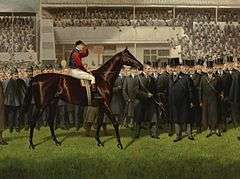Herbert Jones (jockey)
| Herbert Jones | |
|---|---|
 Diamond Jubilee with Herbert Jones up, circa 1900. | |
| Occupation | Jockey |
| Born |
30 November 1880 Epsom, Surrey, England |
| Died | 18 July 1951 (aged 70) |
| Career wins | 540 in U.K. 1896-1923 |
| Major racing wins | |
|
Coronation Stakes (1910) 2,000 Guineas (1900, 1905, 1906, 1909) Epsom Derby (1900, 1909) St. Leger Stakes (1900) Epsom Oaks (1905) | |
| Significant horses | |
| Diamond Jubilee, Minoru, Anmer | |
Herbert Ebsworth Jones[1] (30 November 1880 – 18 July 1951) was an English Thoroughbred horse racing jockey.
He often rode for King Edward VII, and in 1909 he rode the first Derby winner owned by a British Monarch. He remains one of only fifteen jockeys to win the British Triple Crown.
The Triple Crown
Son of the jumping trainer Jack Jones, young Herbert was apprenticed to Richard Marsh at the age of ten and rode his first winner in 1896.
In 1900, he won the British Triple Crown when he rode Diamond Jubilee to victory in the 2,000 Guineas Stakes, Epsom Derby and St. Leger Stakes. He was the work rider for the temperamental Diamond Jubilee and it was noted that this wayward colt went better for him than for any more established jockey. Diamond Jubilee had savaged his race rider Herbert Cannon by rolling on him after a gallop just before the 2000 Guineas. Hence the young Jones got his chance and won the Triple Crown on the Prince of Wales's horse. [2]
Later career

Among his other Classic victories, he won the 1905 Epsom Oaks, a second Derby in 1909, and the 2,000 Guineas on three more occasions.
In 1909 at the Epsom Derby on 26 May, Jones rode Minoru to victory at odds of 7/2 in a field of fifteen. This was the first time a horse owned by a British reigning monarch had won the Derby. The victory for the "Royal" colt provoked "the wildest scenes of enthusiasm ever known in England", including a mass rendition of the National Anthem as the King led his horse to the winner's enclosure.[3]
In 1913, Jones rode Anmer, the King's Horse, in the Epsom Derby. He was involved in a collision with Emily Davison, the suffragette, who was fatally injured. Jones suffered significant injuries himself, including a mild concussion. Fifteen years after the death of Emily Davison, Herbert Jones laid a wreath at the funeral of Emmeline Pankhurst in honour of her and Emily Davison.[4]
Jones retired from riding in 1923. In 1951, soon after his wife's death and his onset of depression, he was discovered to have committed suicide after his son found him in a gas-filled kitchen.[4]
References
- ↑ Arthur F. Meyrick. "The Prince of Wales's Jockeys." The Strand Magazine. Volume 20. Pages 289-296.
- ↑ The National Horse racing museum website retrieved 12.02.2017
- ↑ Amanda Murray (2006). All the King's Horses: A Celebration of Royal Horses. Robson Books. p. 191. Retrieved 2012-02-16.
- 1 2 Vanessa Thorpe "Truth behind the death of suffragette Emily Davison is finally revealed", The Observer, 26 May 2013